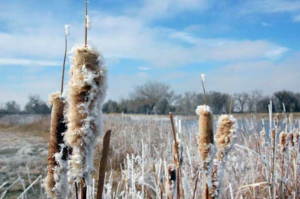“Lakespert” – Does it Matter What We Call It?
Steve Lundt, CLM

Frost encrusted cattails lining a human-made pond that helps treat wastewater. The thermal energy from the treated effluent allows for open water all winter long.
It’s a puddle, a pound, a lake – no, it’s Superpond. It takes on all stormwater, provides bounds of recreation, and provides a great backdrop to any picnic. “Pond” – a universal word that is used for a human-made stormwater BMP, a small lake, a natural pool, a backyard water feature, a livestock pound, and even for the Atlantic Ocean, which dates to the 1640s.
Does it matter what we call it? Yes, the word that we create to call a human-made body of water can be important. I help with a local lake called “Bluff Lake.” I often find it humorous how this name has an appropriate double meaning. Bluff Lake is located next to a small overlook, but the body of water itself can go from a dry lakebed to being a stormwater pond and then back to a tranquil lake in a matter of days. I often can see how this treasured neighborhood pond can be deceptive. Yes, it is a noun but the verb meaning of bluff is also fitting – to deceive, pretending, feign, or give a false appearance.
So, you see why I internally guffaw at hearing the name “Bluff Lake.” Are we talking about the noun or the verb meaning? It is hard to pretend that a human-made pond, even natural ponds for that matter, can behave and be managed like a natural lake. Ponds are typically much shallower, thus having their entire water column in the photic zone year around. Then you add in features like quarry mining (no littoral zone), liner (no groundwater interactions), pipes (stormwater), dams (no outlets) and you clearly end up with a bluff of a lake. Then what?
Human-made ponds that tattoo our communities provide so many unseen benefits but can quickly get a bad reputation. These small impoundments are blamed for all the summertime mosquito bites. These detention basins are eyesores when they bloom with algae. These borrow pits become littered with trash from stormwater. These quarry pools are infested with goldfish. And the list of names and issues goes on.
I do think it matters what we call these human-made ponds. It sets the tone for how we view them and how we invest our limited management resources. They all need protection from humans even though they were built by them. Management plans need to include maintenance, aquatic plant control, fisheries, recreation, waterfowl management, well-protected shorelines, and a comprehensive public outreach effort that educates locals about the importance of freshwater ecosystems. These waterbodies should never be a bluff – every human-made pond deserves our attention no matter what you call it.
 Steve Lundt, Certified Lake Manager, has monitored and worked to improve water quality at Barr Lake (Denver, Colorado) for the past 19 years. Steve is active with the Colorado Lake & Reservoir Management Association and is a past Region 8 director for NALMS and an active member since 1998.
Steve Lundt, Certified Lake Manager, has monitored and worked to improve water quality at Barr Lake (Denver, Colorado) for the past 19 years. Steve is active with the Colorado Lake & Reservoir Management Association and is a past Region 8 director for NALMS and an active member since 1998.

